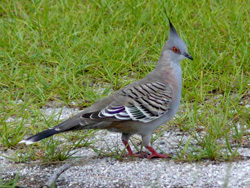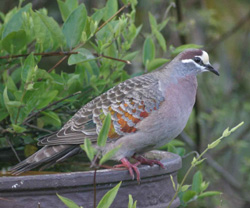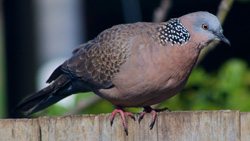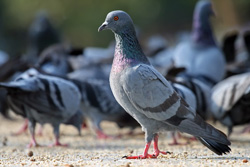Tom Parkinson's monthly column, introducing the diverse range of flora and fauna on show at Sanctuary Lakes.
Shorter days and longer nights open the curtain to autumn in Sanctuary Lakes and with it comes a change in the variation of birds who inhabit our gardens. Due to the lack of spring and summer seeds, worms and insects, some of the more human friendly birds start poking around our habitat searching for the odd scrap or two. Autumn and winter often brings a regular increase of visits from the Dove and Pigeon families. Resident in Sanctuary Lakes are two Australian natives, the Crested Pigeon and the Bronzewing, one import, the Turtle Dove, and one mean gang, the Feral Pigeon.
Is there a difference between Doves and Pigeons? They are all from the same family groups. Some say birds named Pigeon are larger than Doves, but there are too many exception to hold that true. Therefore the short answer is “no”. In myths the Dove is a symbol of peace, with the Pigeon being the messenger.
 The Crested Pigeon (Ocyphaps lophotes)The Crested Pidgeon is easy to recognize due to its feathered but slender black spike on the top of its head and the very distinctive sound of beating and whistling that their wings make when they take off. They are about 32 cm long; their wings have black stripes and are bronzed, while the primary feathers having colourful areas of brown, purple, blue and green. The Crested Pigeon nests annually in the dense bushes around our estate. A very basic nest with two oval white eggs. Both sexes share the incubation of the eggs (21 days) and both care for the young.
The Crested Pigeon (Ocyphaps lophotes)The Crested Pidgeon is easy to recognize due to its feathered but slender black spike on the top of its head and the very distinctive sound of beating and whistling that their wings make when they take off. They are about 32 cm long; their wings have black stripes and are bronzed, while the primary feathers having colourful areas of brown, purple, blue and green. The Crested Pigeon nests annually in the dense bushes around our estate. A very basic nest with two oval white eggs. Both sexes share the incubation of the eggs (21 days) and both care for the young.
The Crested Pigeon can be found in grasslands in both rural and urban areas. Sanctuary Lakes suits their needs with the grassy golf course and boulevards. Also they must live in the vicinity of water, as it is essential to its wellbeing to drink every day. If not in your garden occasionally, they can often be seen early morning and late afternoons by the Golf Course’s fresh water ponds.
 The common bronzewing (Phaps calcoptera)Another Australian Native is the Common Bronzewing, a medium-sized (to 35cm) plump bird with a small head. The male has a cream forehead with brown rear crown and nape and the female has a grey forehead without a brown cap. Both sexes have a clear white line below and around the eye. They also have a greyish pink breast, and distinctive patches of red, blue and green on their wings giving the bronze look of its nomenclature.
The common bronzewing (Phaps calcoptera)Another Australian Native is the Common Bronzewing, a medium-sized (to 35cm) plump bird with a small head. The male has a cream forehead with brown rear crown and nape and the female has a grey forehead without a brown cap. Both sexes have a clear white line below and around the eye. They also have a greyish pink breast, and distinctive patches of red, blue and green on their wings giving the bronze look of its nomenclature.
Common Bronzewing lives in open grass and wood land feeding mainly on the ground, eating seeds and plant matter. Sanctuary Lakes Resort suits them well and although slightly nervous birds, they seem to be at home in the human habitat, scratching amongst the gardens for ground lying tit bits, weeds, leaves and small invertebrates. They even take berries from low branches and bushes and also feeding on cultivated grains. They are often seen in pairs at waterholes. Like the Crested Pigeon, these birds need to drink regularly by day and by night.
When alarmed or threatened, Common Bronzewing crouches on the ground among vegetation, to avoid detection. If it flushes, it takes off readily, with loud clapping of wings.
Breeding is once a year and can be between August and January. They nest in a loose platform made with twigs and sticks, usually low in vegetation, or dense bush.
Female lays 2 creamy-white eggs. Incubation lasts about 2 weeks, shared by both adults.
The young birds are born naked and helpless and are completely dependent on their parents. Bronzewings, like most other pigeons and doves, secrete a special milk-like substance from their crop, which is fed to the young chicks. Young can fly at about 16 days of age, but they remain at nest for about 25 days.
The Common Bronzwing’s distinctive call is an extraordinary mournful deep oom repeated monotonously at metronomic intervals for an interminable length of time. Unfortunately, not a call that would inspire the young composer in search of a tune.
 The spotted dove (Spilopelia chinensis)A native of the Indian sub-continent was introduced in Melbourne in 1860s, the Spotted Dove has since spread to many divergent locations across Australia. Spotted Doves move around Sanctuary Lakes often in pairs as they forage for grass seeds, grains, fallen fruits and seeds of other plants, hopping into gardens often scavenging for bread crumbs and other human food scraps. I have seen a pair once picking out items of a discarded Macca’s pack. Besides Macca’s, they take the occasional insect and have been known to feed on winged termites.
The spotted dove (Spilopelia chinensis)A native of the Indian sub-continent was introduced in Melbourne in 1860s, the Spotted Dove has since spread to many divergent locations across Australia. Spotted Doves move around Sanctuary Lakes often in pairs as they forage for grass seeds, grains, fallen fruits and seeds of other plants, hopping into gardens often scavenging for bread crumbs and other human food scraps. I have seen a pair once picking out items of a discarded Macca’s pack. Besides Macca’s, they take the occasional insect and have been known to feed on winged termites.
Spotted Doves are slighter smaller than other doves and pigeons at 30cms long. They are mostly light pinkish brown above, with darker centres to the feathers of the back and wings. The head is grey, and the neck and underparts are grey-brown, tinged with pink. The distinguishing feature is the large black collar on the base of the hind-neck, which has many white spots. In flight, the distinguishing white-tipped tail can be clearly seen. Their flight is quick, with regular beats and a loud clapping of the wings on takeoff and slowly gliding with the tail spread out upon landing.
Spotted Doves breed annually and at any time of the year, but most activity is from September to December. Similarly to other Doves and Pigeons, their nest is a loose platform of sticks, which is normally placed in dense bushes or small hedge trees. Both sexes share the incubation of the eggs, normally two or three and the rearing of the chicks.
 Feral Pigeon or Rock Pigeon Columba livia domesticaFeral Pigeons, are the domestic homing and racing pigeons that have returned to the wild. The homing pigeons are descended from Rock Pigeon, found in Europe and Asia. A relatively large bird about 38cm with many plumage variants that have been developed by selective breeding over the years but the most common colours of feral birds are a mixture of grey, black, white and brown, with purple and green sheens.
Feral Pigeon or Rock Pigeon Columba livia domesticaFeral Pigeons, are the domestic homing and racing pigeons that have returned to the wild. The homing pigeons are descended from Rock Pigeon, found in Europe and Asia. A relatively large bird about 38cm with many plumage variants that have been developed by selective breeding over the years but the most common colours of feral birds are a mixture of grey, black, white and brown, with purple and green sheens.
Unlike other bird, Feral Pigeon congregate in large flocks. Sanctuary Lakes has at least two such flocks. It is this habit of large communities of birds and high breeding of up to six broodings per annum that make the Feral Pigeon such a pest. Added to this, Feral Pigeons do not migrate far from their birthplace; this can make it extremely difficult to remove from their location. Pigeons are particularly fond of roof spaces and very quickly the large colony of flocking birds will deface the roofs and its building with their droppings. Pigeons are adept at spotting new access points for mass nesting such as loose tiles, following damage caused by strong winds.
The best way to minimize the nuisance if your roof has the misfortune to be chosen by the Feral Pigeon Flock, is to control where they roost, nest and feed. Get rid of all possible food scraps, clean and seal the roof (use spikes and wire netting where appropriate) and destroy all the nests. Done efficiently the flock will move on after a few days of no food, nests or roosts. I can vouch for this as my next door neighbours successfully moved a reasonable sized flock from their roof.